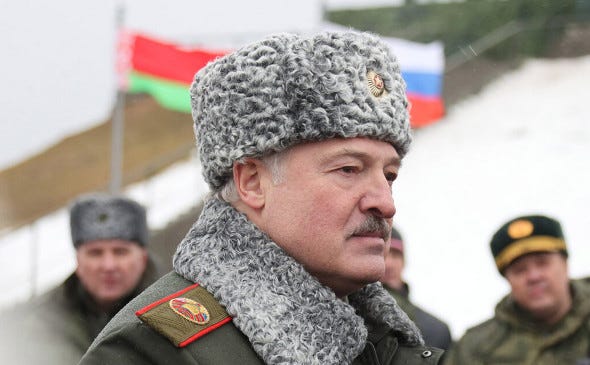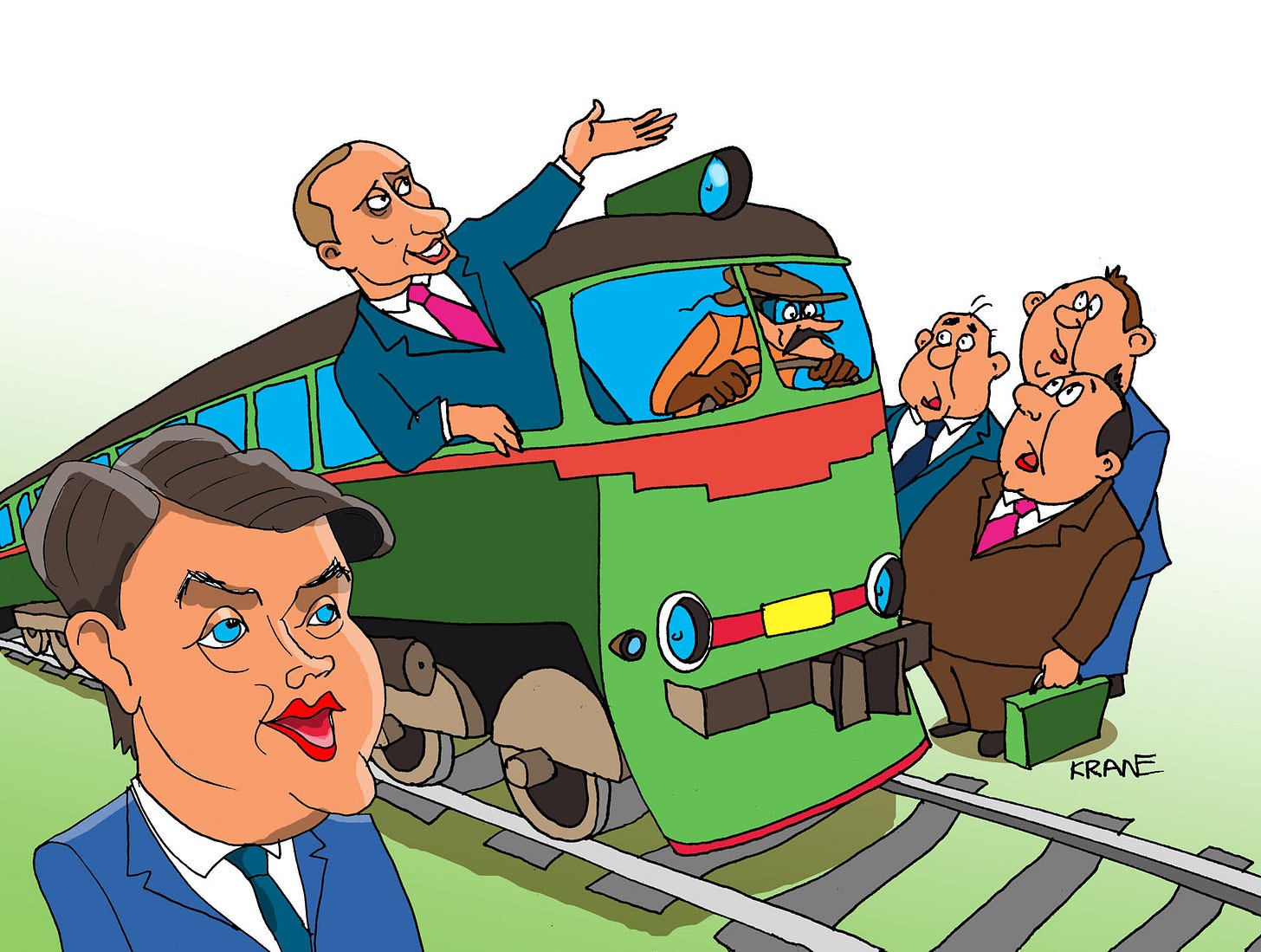Promised … and delivered. Don’t relax. The Gosplan worked better. Something went wrong
February 18, 2022
Promised … and delivered
Russia provided U.S. Ambassador John Sullivan in Moscow with its “response to the earlier American response to the Russian draft treaty between the Russian Federation and the United States on security assurances.” The Russian Foreign Ministry immediately posted the text on its website. Foreign Minister Sergei Lavrov explained Moscow’s commitment to the principle of “open diplomacy” as follows: “We believe that it is absolutely essential that interested members of the civil societies of our countries have an idea of what is going on, an idea of what positions each side is defending.”
The general content of the response has already been voiced by Sergei Lavrov and Russian President Vladimir Putin: Russia has not received answers to its main demands while being ready to engage in dialogue on individual constructive proposals received from Washington.
“We state that the U.S. side has not given a constructive response to the essential elements of the draft treaty with the U.S. on security guarantees prepared by the Russian side.”
“The package nature of the Russian proposals was ignored, from which ‘convenient’ topics were deliberately chosen, which, in turn, were ‘twisted’ to create advantages for the United States and its allies.
“The stationing of the armed forces of the Russian Federation on its territory does not and cannot affect fundamental United States interests... We insist on withdrawing all United States armed forces and armaments stationed in Central and Eastern Europe, South-Eastern Europe, and the Baltic States. We are convinced that the national capabilities in these zones are sufficient.
“The United States has not responded to such an element of the ‘package’ of measures proposed by us as the withdrawal to the national territory of nuclear weapons deployed outside it and refraining from their further deployment outside national territory. What is at stake is the problem of the presence in the territory of some non-nuclear NATO States—in violation of the NPT—of U.S. nuclear weapons capable of hitting targets on Russian territory... Without eliminating this irritant, discussion on non-strategic nuclear weapons is impossible.
“We note that the U.S. takes as a basis the Russian approach, which provides for the mutual settlement of counter concerns in the context of the former Treaty on the Non-Proliferation of Nuclear Weapons. The option proposed by the U.S. side to develop our idea of mutual verification measures concerning the Aegis Ashore complexes in Romania and Poland and some facilities in the European part of Russian territory may be taken up in the future.
“Regarding the prevention of incidents on the high seas and in the airspace above it, we welcome the readiness of the U.S. for appropriate consultations.
“In the absence of the willingness of the American side to agree on firm, legally binding guarantees to ensure our security on the part of the United States and its allies, Russia will be forced to respond, including by implementing measures of military and technical nature.”
Continuing mutual expulsions
U.S. Deputy Ambassador to Moscow Bart Gorman has been expelled from Russia by the Russian authorities before his tour of duty expired. The Russian Foreign Ministry said it was in response to the expulsion from Washington of a Russian envoy adviser.
“...the State Department demonstratively ignored our request to extend his stay at least until the arrival of his ‘replacement.’ As a result, he had to leave without a replacement, which exacerbated an already-critical shortage of staff in the Russian diplomatic mission.”
Besides the tensions between Moscow and Washington over overall embassy staffing, Bart Gorman’s expulsion is tied to the State Department’s demand for a three-year term limit for Russian diplomats in Washington, as stipulated for American diplomats. Russia insists it has the right to determine the duration of its representatives’ trips.
Don’t relax
President of Belarus Alexander Lukashenko has decided that even limited de-escalation in Russian-American relations is unsuitable for him and has “added wood to the fire.”
He said that the future of the Russian troops arriving in Belarus had not yet been decided and that he has this issue for determination with the Russian President on February 18.
“As we make a decision tomorrow, that is how it will be. If we decide, they will be withdrawn within a day. If we decide for a month, they will stay there for a month. The Armed Forces will stay here as long as necessary. This is our land, our territory. We work here, we study and will continue studying,” stated Lukashenko.
Besides, the Belarusian leader stated that some part of the ammunition brought from Russia before the joint Russian-Belarusian training Union Resolute-2022 could remain in Belarus. “We have agreed: If we need any ammunition, not to lug it here and there; we will leave it here.”
In addition, Lukashenko reiterated his thesis that he was ready to deploy nuclear weapons in Belarus.
“If necessary, if our rivals take such stupid steps, we will place not only nuclear weapons but also super-nuclear ones to defend our territory.”
He also said he is ready to make his country’s territory available to expand Russia’s air defense system. According to him, Belarus now has the S-400 complex, and the Belarusian military is mastering it.
“If it’s necessary, we’ll supply a couple more units. But we do not need more. This is a weapon that ‘sees’ at a distance of, I think, 600 kilometers. Where will we put it? Six hundred kilometers of target detection. We are talking about buying several of these units. We can install them somewhere to the east of Minsk or near Minsk, and we will see what is done in Kyiv, behind Warsaw, and so on.”
To that, Lukashenko added that it is enough to install S-300 systems—with two or three times less range—for the defense of Belarus.
The Ministry of Finance is ready to spend more
Inflationary surge makes adjustments to the government’s financial plans: The budget for the current year is based on the forecast inflation rate of 4%, and the need for additional indexation of expenditures is becoming more urgent each day. The law on additional indexation of pensions has already been passed, a bill on the indexation of pensions for military servicemen is in the process of being passed, and the “construction lobby” in the government insists on indexing the costs of investment programs because of the increased cost of construction materials and work.
The Finance Ministry is not opposed to increasing nominal budget revenues since inflation increases budget revenues unrelated to oil prices. Concurrently, the high level of world oil prices guarantees the stability of the entire budget structure. At the same time, Finance Minister Anton Siluanov stressed that the budget amendments would not affect the ongoing policy of budget consolidation: Revenues and expenditures will be increased by the same amount, maintaining the budget surplus. According to preliminary estimates, the increase in expenses may amount to about 1 trillion rubles (a little less than 5% of the approved budget expenditures for the year). Still, the impact of this decision on macroeconomic parameters cannot be estimated today: It is necessary to wait for the distribution of expenditures. Last year’s example showed that the increase in spending on investment by 500 billion rubles led to a sharp acceleration of inflation for basic construction materials and services of construction companies.
The Gosplan worked better
Vladimir Putin is sure that he (and his ministers) make the best economic decisions, beneficial to the economy. Practice, however, shows that the President and the government make many decisions ad hoc, within the framework of the narrow problem at hand, while forgetting about the decisions made earlier.
This situation can be seen in the distribution of railroad capacity for freight exports to Pacific ports (the so-called “Eastern Range”).
In May 2020, when the second stage of the Trans-Siberian Railway and BAM expansion was coming to an end, the government approved the rules of non-discriminatory access for freight transportation in those directions where throughput capacity is limited. In the terms of this document, the first to go are cargoes for liquidation of emergencies, then—according to the President’s decisions—subsidized cargo, containers and refrigerators, domestic loads, non-resource export, raw materials in specialized railcars, grain, and foodstuffs; export of raw materials in multipurpose railcars (including coal) comes next, and then all other cargoes.
However, in March last year, President Putin decided that export transportation of coal from Kuzbass, which takes 37% of the capacity of the Eastern polygon, should become a super-priority. Russian Railways were able to fulfill this decision by halving the export of coal from Buryatia and Khakassia, which required fresh intervention of the President. Considering the increase of coal export from Kuzbass and Yakutia and restoration of coal export from Buryatia and Khakassia, Deputy General Director of Russian Railways Aleksey Shilo estimates that in 2022, coal will take about 75% of the carrying capacity of the Eastern polygon.
This Kremlin fascination with coal exports creates enormous problems for the rest of the economy, ready to export cargoes with higher added value. According to Anatoly Golomolzin, an advisor to Transcontainer’s president, “...due to the lack of confirmation [from Russian Railways about its readiness to carry cargoes],” his company is stuck with 40-50 undelivered trains every month.”
Something went wrong
In 2017, the Bank of Russia decided to bail out banks independently in a difficult financial situation. Until then, such banks had been bailed out by other banks, which had received long-term, low-interest loans from the Bank of Russia for this purpose. Practice showed that no one bank with problems had been rehabilitated while the banks in charge of rehabilitation used loans for their purposes. To manage the bailout process, in mid-2017, the Bank of Russia created a particular Bank System Consolidation Fund and a management company under the control of the Bank of Russia. In 2017-2019, the Bank of Russia decided to bail out 10 banks; one of them managed to get back on its feet and sold in October 2021; the rest remain under the ownership of the Central Bank.
In January 2019, the Bank of Russia announced the bailout of Moscow Industrial Bank (MInB), for which it allocated 128.7 billion rubles. The original plan was to spin off bad assets from IINB, which accounted for 12.4% of its portfolio, and sell them to Trust Bank, while the healthy part of IINB was merged with Promsvyazbank. The rehabilitation scheme planned to sell the assets by August 1, 2021, and merge them by January 1, 2023. However, something went wrong, and the process of MInB rehabilitation was halted, as Alexander Sokolov, Trust’s CEO, said.
“The idea was abandoned. There is no process. Another decision was made, our shareholder made the decision. We just felt that there was no expediency in it. We chose another way. You have to ask the Central Bank about it in more detail because we would simply follow the decision.”
The Bank of Russia did not comment on this issue, and the reasons for the delay can only be guessed. One hypothesis is that the Bank of Russia cannot organize the work of FCBS: Over 4.5 years of its existence, the management company had four directors. Another hypothesis is that the “bad assets” of IIB were not very bad, and someone among the investors turned out to be interested in buying them on better terms than those who agreed with Trust. Now the Bank of Russia is thinking about arranging such a deal.







